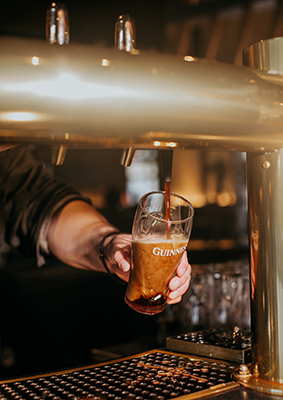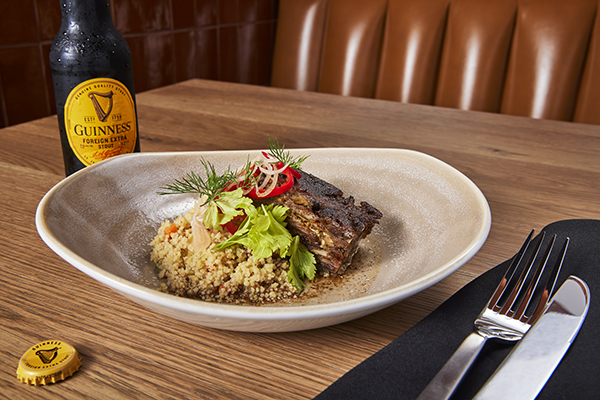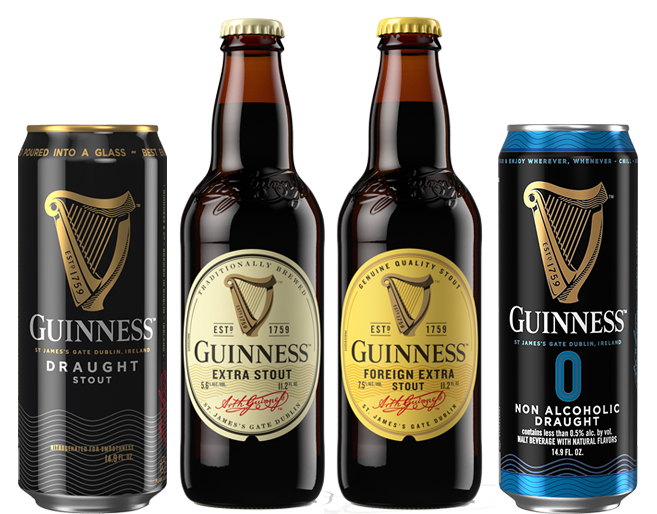A Wide Variety of Consumers are Realizing That a Brand Born in 1759 Has Modern Appeal.
By: Joshua M. Bernstein
Mountainous Asheville, North Carolina, contains one of America’s densest concentrations of breweries per capita. Beer drinkers can order local IPAs, sour ales, and lagers at bars and taprooms around town. Until recently, Asheville’s bounty was short one memorable beer:
“You couldn’t get a pint of properly poured Guinness,” says Jesse Van Note, a founder of the Whale, a group of craft beer bars based in Asheville that also serve classic German and Belgian beers. “We wanted to be the place.”

At the time, the Whale dedicated its nitro line to North Coast’s Old Rasputin Russian Imperial Stout. But Old Rasputin sold slowly due to its 9% ABV. Perhaps Guinness Draught could boost sales velocity via its 4.2% ABV and 125 calories per 12-ounce serving. “It’s a diet beer,” says cofounder Andrew Ross. “Guinness is a forever love.”
Van Note and Ross invested in proper glassware and training to ensure lustrous 20-ounce pours. Now, the Whale sells inexpensive $6 Imperial pints of Guinness at its locations in Asheville and both Charleston and Greenville, South Carolina. “It would be a disservice to offer a broad spectrum of beer and not sell Guinness,” Ross says.
Guinness is among the world’s most iconic beer brands. The silky Draught Stout is a staple at sports bars and Irish pubs, widely toasted during St. Patrick’s Day. For all its popularity, Guinness can be pigeonholed into seasons, occasions, and a single memorable presentation.
“If you say the word ‘Guinness,’ so many people imagine that pint of Guinness Draught Stout alone by itself on the end of a beautiful wooden bar,” says Ryan Wagner, Head of Marketing and National Ambassador for Guinness. “Guinness is a brewery, not a beer.”

The company’s portfolio includes the sweetly roasty Extra Stout, carbonated and 5.6% ABV; Guinness 0 Non Alcoholic Draught; easygoing Baltimore Blonde; and robust and espresso-like Foreign Extra Stout, which dates to 1801. “I love it when someone says, ‘I’ll take the original Guinness,’” Wagner says. “I go, ‘OK, the oldest recipe we have in market is the Foreign Extra Stout.’”
Here’s how bar owners and sales reps are bringing the full range of Guinness into new venues and occasions, helping the brand remain front and center 365 days of the year.
Seeking Sales Beyond the Traditional Irish Pub
Irish pubs are warm bastions of civic togetherness and tradition, bar stools and booths filled with post-shift workers and folks craving cold Guinness and warm conversation. Brendan Donohoe, a hospitality veteran and native of Dublin, Ireland, realized there was a glaring need for that same welcoming space for New York City’s queer community. Last year, he converted a Brooklyn beer shop into Mary’s Bar, a queer Irish pub.

The public house is “forging a new path for queer establishments,” says Donohoe, who is gay. He conceived of Mary’s as a reflection of modern Ireland’s diversity and cultural and political growth. TVs are banned from the cozy bar, where customers can crunch crisps while listening to traditional Irish music – performed by queer musicians – and sipping Guinness.
“Having a really good pint of Guinness has always been incredibly important to any Irish operator of a bar,” Donohoe says. “I would probably have a seizure if I saw somebody just drop the glass, pour it, and walk away.”
As craft beer boomed in the 2010s, bars focused on local, independent, and unusual beer, leaving few taps for benchmark beers. Nowadays, craft beer specialists are seeing the benefit of offering Guinness. The Whale offers 20 beers, plus scores of international bottles, but sometimes “people will come in and be [overwhelmed by] so much beer,” Ross says. “They’re like, ‘I just want a pint.’ ” The bar’s house pilsner and Guinness are simplified fallbacks for overwhelmed customers. “That’s our dark and our light,” he says.
In Philadelphia, Guinness is regularly served beside some of the best local and national craft beer. Fountain Porter serves IPAs from Maine Beer Company alongside Guinness Draught. Pub on Passyunk East, or P.O.P.E, pours Guinness Draught and plenty of Tröegs beer. And at Meetinghouse, located in the former home of beloved beer bar Memphis Taproom, the tightly edited beer list contains five draughts.
Meetinghouse offers three house beers (a pale, dark, or hoppy ale), the Trappist ale Orval, and Guinness. “That’s my favorite beer,” says cofounder and brewer Colin McFadden, who previously worked at Tired Hands. The slim, static beer selection and careful inclusion of archetypal beers is a rebuttal to the last decade’s exuberant excesses – queuing for cans at breweries, bars endlessly rotating taps, new beers appearing and disappearing weekly. Why complicate the pleasure of a pint?
“One of the objectives of a drinking establishment is to keep it fun and keep it relatively easy for people,” McFadden says.
Food and Cocktails Can Expend Interest in All Things Guinness
One challenge for Guinness is introducing consumers to brands beyond Draught Stout. Diageo’s two Guinness Open Gate Breweries, in Baltimore and Chicago, showcase the company’s experimental brewing streak that encompasses corn lagers and Belgian-style witbiers fermented with Guinness yeast. Trying taproom-only beers requires an in-person visit, limiting their power to sway broad perception.

Trial is tougher still for Extra Stout and Foreign Extra Stout. “They’re very much off-premise products,” Wagner says. “We’ve got to look for ways to reach different consumers and meet them where they are.”
It helps to zoom out and think of Guinness as a global brand, Ireland only one part of its identity. Extra Stout and Foreign Extra Stout are popular in the Caribbean, West Africa, Southeast Asia, and beyond, and those cuisines can complement both beers’ bold flavors.
Contemporary Caribbean restaurants, such as Miss Lily’s in New York City, offer jerk chicken and ramen with Guinness 0 and Foreign Extra Stout, and you’ll find Guinness on draught and in bottles at Era, an Ethiopian dive bar in Philadelphia serving spongy injera with misir wot, or simmered red lentils.

Irish pubs and English pubs also commonly play with the flavors of India, in particular curries. “Some of those flavors that really speak to the beers like Extra Stout and Foreign Extra,” Wagner says.
Take the Dandelion, which offers Philadelphians a refined take on the modern British pub. It serves cans of Guinness Draught Stout, but wouldn’t tandoori chicken go better with Extra Stout? “There’s an opportunity to expand inside outlets for Guinness beer,” Wagner says.
Guinness Brewery Ambassador Zack Berger is also seeing cocktail bars use concentrated Guinness syrups and the stouts as an ingredient. A touch of Guinness can lend roasty depth to an espresso martini or bloody Mary.
Steakhouses are also an opportunity thanks to a scientific kinship: A browned steak and the roasted barley used in Guinness both undergo the Maillard reaction. The lessons can be applied to home. “Guinness Extra Stout is the perfect companion to a cookout,” says Wagner. “If I’m doing burgers on the grill, that’s the beer I want.”
Pairing dark beers with summertime activities can re-wire beliefs that stouts are best during cold and gloomy weather. An icy light lager is a great grilling companion, but it’s less appealing as it warms up. Guinness Extra Stout will reveal nuanced flavors and aromas with warmth. “We need to expand the understanding of Guinness being appropriate when the weather is warm, the sun is out, and you’re outside,” Wagner says.
Guinness is also suitable if you’re not consuming alcohol. With mindful drinking continuing to grow, Guinness 0 can build a bridge to new consumers and consumption patterns. “It encourages more of a pub culture in the United States, which I feel has always been missing,” Wagner says. Have a round of Guinness Draught, and then a 0, to extend the good times. Or just grab a Guinness 0, its hue, mouthfeel, and trademark foam identical to Draught Stout. The only thing missing is the alcohol.
“It can lead to people enjoying our brands year-round,” Berger says.
The Magic of Guinness Available in Four Mouth-Watering Stouts
Over 260 years in the making, Guinness beers are adored all over the world. From the original to a non-alcoholic offering, they are readily available to be enjoyed all year long.

GUINNESS DRAUGHT STOUT
With its distinctively dark appearance and velvety smooth finish, Guinness Draught strikes the perfect balance between bitter and sweet with roasted barley, hops for bittering and malt extract. The malted barley is roasted in a similar way to coffee beans, which gives Guinness its distinctive dark color and stormy profile. This iconic beer is defined by harmony. Sip after sip, sweet counters the bitter as the malts arrive on cue to complement the roasted barley. With notes of coffee and dark chocolate, Guinness Draught is velvety smooth with a sweet malty nose.
GUINNESS EXTRA STOUT
Smooth at first with bold flavors that develop on the tongue, Guinness Extra Stout has a mild, boozy bite with a dry finish. The perfect balance of bitter and sweet, this beer has the rich, roast characters of the barley and a distinctive fruitiness from fermentation. With a luxurious, dark color and full-bodied creamy head, hints of coffee, caramel and toffee add to the rich experience of this stout. Sharp and crisp to the taste, it’s an entirely different experience from the smooth, creamy Guinness Draught and punchier Foreign Extra Stout, but the trademark Guinness flavors preside.
GUINNESS FOREIGN EXTRA STOUT
Foreign Extra Stout is brewed with generous hops and roasted barley for a bittersweet balance and a full-flavored, natural bite. Developed over 200 years ago for global export from Ireland, the addition of extra hops ensured this stout would arrive to its destination in perfect condition. Full-bodied with lots of flavor, a robust bitterness and creamy texture, this beer pairs perfectly with smoked meats and chocolate desserts.
GUINNESS 0 NON ALCOHOLIC DRAUGHT
Brewed at St. James’s Gate in Dublin, each pint of Guinness 0 Non Alcoholic Draught is packed with the same quality Irish malt and roasted barley as the Guinness Draught Stout you know and love. It’s all the remarkably smooth and delicious taste without the alcohol!
About the Author: Award-winning beer journalist Joshua M. Bernstein is the author of six books, including The Complete Beer Course.
